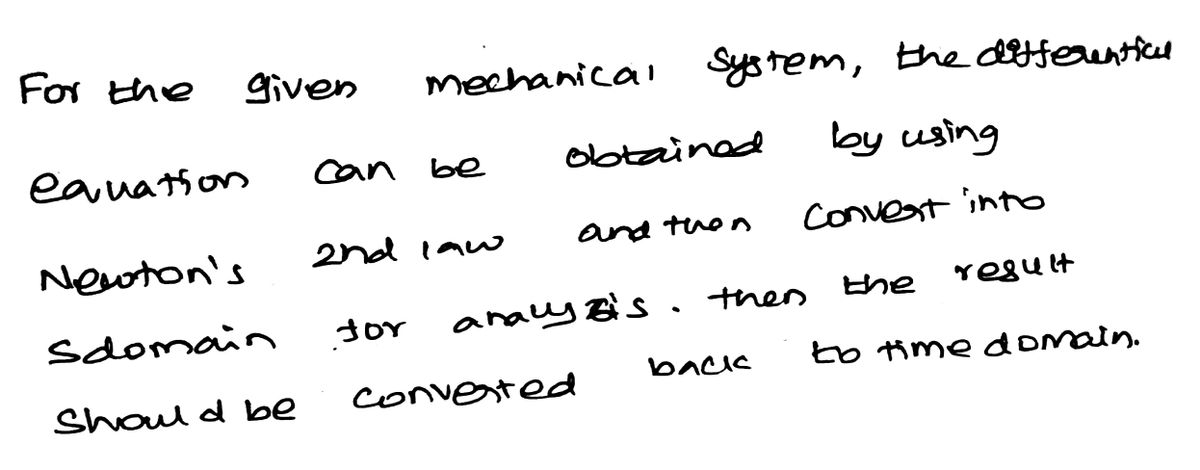Refer to the diagram - assume the weight of mass m=1 kg is hanging from a ceiling (held in place at x=0) and then let go at t=0. The damper and the spring inovolved have the following coefficients Kp = 20/s, K, = 125 N /m Write the Newton's 2nd law equation for the free-body diagram of the weight (similar to what we did in class recording), and then solve the equation (via Laplace transform) to find the behavior of displacement over time x(t). (What kind of function is x(t)?) For simplicity, assume the approximation for the acceleration of the force of gravity is g = 10 What is the final value of the displacement x(t)?
Refer to the diagram - assume the weight of mass m=1 kg is hanging from a ceiling (held in place at x=0) and then let go at t=0. The damper and the spring inovolved have the following coefficients Kp = 20/s, K, = 125 N /m Write the Newton's 2nd law equation for the free-body diagram of the weight (similar to what we did in class recording), and then solve the equation (via Laplace transform) to find the behavior of displacement over time x(t). (What kind of function is x(t)?) For simplicity, assume the approximation for the acceleration of the force of gravity is g = 10 What is the final value of the displacement x(t)?
Introductory Circuit Analysis (13th Edition)
13th Edition
ISBN:9780133923605
Author:Robert L. Boylestad
Publisher:Robert L. Boylestad
Chapter1: Introduction
Section: Chapter Questions
Problem 1P: Visit your local library (at school or home) and describe the extent to which it provides literature...
Related questions
Question

Transcribed Image Text:Refer to the diagram - assume the weight of mass m=1 kg is hanging from a ceiling (held in place at x=0)
and then let go at t=0. The damper and the spring inovolved have the following coefficients Kp =
20 /s, K, = 125 N/m
m
Write the Newton's 2nd law equation for the free-body diagram of the weight (similar to what we did in
class recording), and then solve the equation (via Laplace transform) to find the behavior of
displacement over time x(t). (What kind of function is x(t)?)
For simplicity, assume the approximation for the acceleration of the force of gravity is g = 10
What is the final value of the displacement x(t)?

Expert Solution
Step 1

Trending now
This is a popular solution!
Step by step
Solved in 2 steps with 4 images

Knowledge Booster
Learn more about
Need a deep-dive on the concept behind this application? Look no further. Learn more about this topic, electrical-engineering and related others by exploring similar questions and additional content below.Recommended textbooks for you

Introductory Circuit Analysis (13th Edition)
Electrical Engineering
ISBN:
9780133923605
Author:
Robert L. Boylestad
Publisher:
PEARSON

Delmar's Standard Textbook Of Electricity
Electrical Engineering
ISBN:
9781337900348
Author:
Stephen L. Herman
Publisher:
Cengage Learning

Programmable Logic Controllers
Electrical Engineering
ISBN:
9780073373843
Author:
Frank D. Petruzella
Publisher:
McGraw-Hill Education

Introductory Circuit Analysis (13th Edition)
Electrical Engineering
ISBN:
9780133923605
Author:
Robert L. Boylestad
Publisher:
PEARSON

Delmar's Standard Textbook Of Electricity
Electrical Engineering
ISBN:
9781337900348
Author:
Stephen L. Herman
Publisher:
Cengage Learning

Programmable Logic Controllers
Electrical Engineering
ISBN:
9780073373843
Author:
Frank D. Petruzella
Publisher:
McGraw-Hill Education

Fundamentals of Electric Circuits
Electrical Engineering
ISBN:
9780078028229
Author:
Charles K Alexander, Matthew Sadiku
Publisher:
McGraw-Hill Education

Electric Circuits. (11th Edition)
Electrical Engineering
ISBN:
9780134746968
Author:
James W. Nilsson, Susan Riedel
Publisher:
PEARSON

Engineering Electromagnetics
Electrical Engineering
ISBN:
9780078028151
Author:
Hayt, William H. (william Hart), Jr, BUCK, John A.
Publisher:
Mcgraw-hill Education,